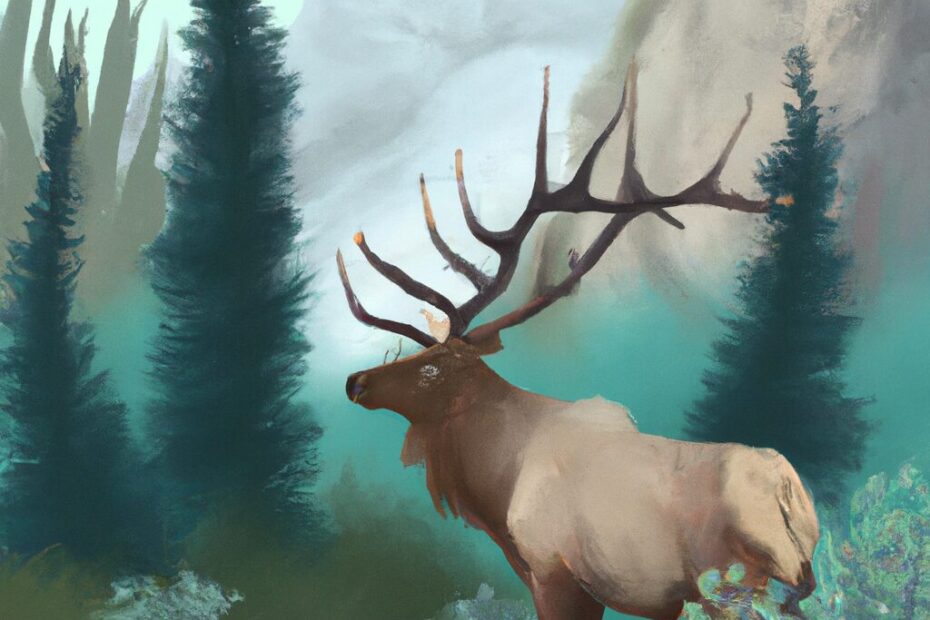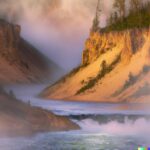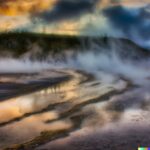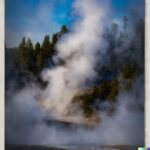Yellowstone National Park is home to some of the world’s most unique and stunning geysers, making it a must-see destination for nature lovers and adventure seekers. But planning a visit to these natural wonders requires careful consideration of several factors, including weather, crowds, and accessibility.
In this comprehensive guide, we’ll explore the best time of year and day to visit Yellowstone geysers, as well as provide tips for making the most of your experience while respecting the park’s natural environment and wildlife. Whether you’re a first-time visitor or a seasoned explorer, this article has everything you need to plan an unforgettable trip to Yellowstone’s geysers.
What Makes Yellowstone Geysers Unique?
Yellowstone National Park is renowned for its unique geothermal features, making it home to some of the world’s most spectacular geysers, hot springs, steam vents, and thermal basins.
The mesmerizing landscapes of Yellowstone’s geysers and thermal features display an awe-inspiring blend of vibrant hues and captivating patterns. These natural wonders create a surreal environment that attracts visitors from all around the globe.
The bubbling hot springs, erupting geysers, and bubbling mudpots showcase Earth’s raw power, reminding us of the park’s importance as a premier geothermal site. The continuous release of steam and water from the geysers and hot springs creates a symphony of natural elements that is both fascinating and humbling.
Factors to Consider When Planning a Visit to Yellowstone Geysers
When planning a visit to Yellowstone’s geysers, it’s crucial to consider various factors such as travel arrangements, peak times, safety and wildlife viewing, as well as the availability of accommodations and facilities within the park.
When planning a trip to the park, it’s important to consider logistics such as transportation and parking. Knowing when the park is busiest can help you plan your visit and avoid crowds. Safety is also crucial, especially when it comes to geothermal features and wildlife. Additionally, staying in accommodations near the geysers can make your trip more convenient and enjoyable.
Weather and Climate
The weather and climate at Yellowstone can significantly impact the experience of visiting the geysers and the national park as a whole, with each season showcasing unique natural phenomena, from the vibrant blooms of spring to the serene snowscapes of winter.
In spring, the melting snow and increased precipitation lead to a surge in geyser eruptions, creating breathtaking displays of water and steam.
Summer brings longer days and milder temperatures, making it an ideal time for exploring the park’s diverse flora and fauna.
Fall transforms the landscape with golden hues and cooler weather, offering a picturesque backdrop to the geysers.
Winter blankets Yellowstone in a quiet beauty, with geysers surrounded by snow-covered landscapes, providing a magical and more solitary experience for visitors.
Crowds and Peak Season
Understanding the patterns of tourist crowds and the concept of peak and off-peak seasons is essential for planning a visit to Yellowstone’s geysers, ensuring a more enjoyable and fulfilling experience amidst the park’s natural wonders.
During peak seasons, such as summer, Yellowstone can be bustling with visitors, leading to long queues, crowded attractions, and limited accommodation options.
On the other hand, off-peak periods, like late fall or early spring, offer a more tranquil atmosphere with fewer tourists, allowing for a more intimate exploration of the park’s unique features.
By strategically timing your visit and making reservations in advance, you can avoid the stress of large crowds and fully appreciate the park’s pristine beauty.
Accessibility and Road Conditions
Understanding the accessibility and road conditions within Yellowstone National Park is crucial for visitors planning to experience the geysers, whether through a scenic road trip, shuttle service, or a guided tour to navigate the park’s diverse terrain and attractions.
Visitors to Yellowstone have a variety of transportation options to explore the park. They can choose to self-drive along the well-maintained roads or take advantage of the park’s free shuttle service.
When planning a visit, it’s essential to consider the distances between attractions and allocate sufficient time for travel, especially during peak seasons. Route planning should take into account the park’s vast size and the potential for wildlife encounters on the roads. It’s important to stay updated on road conditions, as they can change due to weather and other factors.
Planning ahead and choosing the best transportation method based on individual preferences and accessibility needs can enhance the overall Yellowstone experience.
Best Time of Year to Visit Yellowstone Geysers
Determining the best time of year to visit Yellowstone’s geysers involves considering the unique attractions and natural phenomena offered during each season, from the vibrant blooms of spring to the tranquil snowscapes of winter.
Spring is an ideal time to witness the park coming to life with lush greenery and blossoming wildflowers, creating a picturesque setting.
During summer, the gushing geysers against the backdrop of clear blue skies and warm temperatures make for a memorable sight.
Fall, with its colorful foliage, paints a stunning panorama around the geysers, while winter transforms the landscape into a serene wonderland, offering a completely different but equally captivating experience.
Spring (April – May)
Spring at Yellowstone brings a burst of vibrant blooms, renewed wildlife activity, and the potential to witness awe-inspiring geyser eruptions amidst the tranquil beauty of the reawakening park.
The lush meadows dotted with colorful wildflowers create a stunning backdrop for encounters with bison, elk, and grizzly bears. The air is filled with melodies of songbirds and the bustling energy of young animals.
Visitors also have the chance to witness the magnificent eruptions of Old Faithful and other geysers, adding an extra layer of excitement to the already stunning natural panoramas.
Summer (June – August)
Summer transforms Yellowstone into a thriving habitat, offering abundant wildlife sightings, geyser eruptions, and endless opportunities for outdoor adventures and scenic sightseeing amidst the park’s natural wonders.
The summer season in Yellowstone presents a remarkable chance to witness the awe-inspiring eruptions of iconic geysers like Old Faithful, creating a mesmerizing spectacle against the backdrop of the park’s diverse landscapes.
Visitors can embark on exhilarating hikes through verdant meadows, enchanted forests, and alongside pristine rivers, providing an immersive experience in the heart of nature. Encounters with bison, bears, and elusive wolves further enhance the thrill of exploring the park’s untamed wilderness, making it an unforgettable destination for nature enthusiasts and adventure seekers.
Fall (September – October)
Fall at Yellowstone paints the landscape with breathtaking hues, offers unique wildlife encounters, and presents ideal conditions for hiking adventures amidst the park’s colorful tapestry of natural beauty and autumnal charm.
Exploring the park during the fall season provides an unparalleled opportunity to witness the stunning natural transition. The crisp, cool air and golden hues of the foliage create an enchanting atmosphere for hikers.
As you wander through the trails, you may come across elk bugling in the distance or spot a majestic bald eagle soaring overhead. The glistening rivers and waterfalls add a serene touch to the already mesmerizing scenery, making it a truly captivating experience for nature enthusiasts.
Winter (November – March)
Winter transforms Yellowstone into a serene wonderland, offering captivating wildlife interactions, tranquil snowscapes, and a range of unique activities such as snowshoeing and wildlife tracking amidst the park’s snow-covered splendor.
The snowy landscape of Yellowstone provides a picturesque setting for observing the park’s diverse wildlife, including bison, elk, and wolves. Visitors can embark on guided wildlife tours to witness these magnificent creatures in their natural habitat, creating unforgettable memories.
The park’s geothermal features, such as the iconic Old Faithful geyser, take on a breathtaking appearance against the snowy backdrop, making it a must-see spectacle during the winter months. The contrast of steaming geysers against the frosty surroundings adds to the allure of Yellowstone’s winter adventures.
Best Time of Day to Visit Yellowstone Geysers
Selecting the best time of day to visit Yellowstone’s geysers involves considering the unique atmospheric conditions and geothermal activity that peak during the early morning, late afternoon, and evening hours, enhancing the visual spectacle and natural wonders of the park.
During the early morning, the rising sun creates a breathtaking backdrop, illuminating the billowing steam from the geysers. The cool, crisp air heightens the sensory experience, allowing visitors to witness the geothermal features in all their splendor.
In the late afternoon, the combination of golden sunlight and lingering thermal activity casts an enchanting glow over the landscape, while the tranquil evening hours offer a peaceful ambiance, with the geysers casting mesmerizing silhouettes against the dusky sky. Each time of day presents its own captivating display, inviting exploration and wonder.
Early Morning
Early mornings at Yellowstone offer a serene and prime opportunity to witness majestic geyser eruptions and capture stunning photographic moments amidst the tranquil beauty of the awakening geothermal landscape.
The soft early morning light, coupled with the rising mist from the geysers, creates a magical ambiance that is perfect for photography.
As the surrounding wildlife starts to rouse from slumber, you have the chance to capture the interplay between nature’s marvels and its inhabitants. The stillness of the morning also allows for undisturbed observation of the vibrant colors and shapes of the geysers, adding an extra dimension to the photographic experience.
Late Afternoon
Late afternoons at Yellowstone offer enchanting geyser eruptions and ideal conditions for scenic sightseeing, allowing visitors to immerse themselves in the captivating geothermal displays amidst the park’s natural wonders.
As the sun begins to lower in the sky, the vibrant hues of the landscape are intensified, creating a magical backdrop for the eruptions.
The combination of the geysers’ sporadic bursts and the golden hour lighting invites photographers and nature enthusiasts to capture unforgettable moments.
The dynamic steam plumes and the surrounding flora and fauna further add to the visual splendor, making it an opportune time to witness the full spectrum of Yellowstone’s scenic grandeur.
Evening
Evenings at Yellowstone offer a mesmerizing ambiance for geyser eruptions and wildlife viewing, creating a captivating tapestry of natural wonders and geothermal activity under the tranquil hues of twilight.
As the sun sets over the diverse landscape, the geysers come to life in a dramatic display of power and beauty. The steam rising from the hot springs creates an ethereal atmosphere, adding to the allure of the evening.
This setting provides an ideal backdrop for observing the park’s diverse wildlife, as animals emerge from their hiding spots to begin their nocturnal activities. Visitors have the potential for immersive encounters with bison, elk, wolves, and more as they explore the park during these magical hours, making for an unforgettable experience.
Other Tips for Visiting Yellowstone Geysers
To optimize readability and SEO, it’s advisable to break paragraphs into concise, easily digestible sentences. Add
tags to the text given and aim for a maximum of two sentences per
tag section, allowing multiple
tags. This approach enhances user experience and search engine indexing. Also, add tags to important keywords and phrases, and tags for quotes.
In addition to selecting the best time and day for visiting Yellowstone’s geysers, visitors should also consider geyser predictions, trail etiquette, wildlife encounters, appropriate gear, and respectful behavior to ensure a safe and fulfilling experience amidst the park’s natural wonders.
Understanding geyser predictions can enhance the chances of witnessing a spectacular eruption. Apps and visitor centers offer valuable information to help plan your visit.
When hitting the trails, it’s important to maintain a safe distance from wildlife. Carrying bear spray and practicing animal-aware behavior is advised for your safety.
Make your exploration more comfortable and safe by wearing sturdy footwear, carrying water and snacks, and dressing in layers.
Respecting the environment is crucial. Stay on marked paths and refrain from littering to ensure the preservation of this extraordinary natural habitat.
Check the Geyser Predictions
Prior to visiting the geysers, it’s essential to check the geyser predictions and seek guidance from park rangers to optimize the chances of experiencing mesmerizing eruptions and geothermal displays at Yellowstone.
By understanding the predicted eruption times, visitors can plan their day to witness the powerful bursts of water and steam. This not only enhances the overall experience but also ensures safety, as geysers are natural wonders that demand respect and caution.
Park rangers can provide invaluable insights, helping visitors locate lesser-known but equally captivating geysers, creating a more personalized and memorable exploration of the park’s geothermal wonders.
Stay on Designated Trails
Adhering to designated trails is essential for visitor safety, wildlife conservation, and the preservation of the park’s natural environment. This ensures a responsible and respectful approach to exploring Yellowstone’s geothermal wonders.
Visitors can minimize the risk of encountering dangerous wildlife and protect fragile ecosystems by staying on designated trails. These paths are carefully planned to lead visitors to iconic features while minimizing human impact on sensitive areas.
Following these designated paths also helps preserve the park’s unique geothermal features and prevents erosion, ensuring future generations can continue to enjoy the park’s natural beauty.
Bring Appropriate Gear and Clothing
Bringing appropriate gear and clothing is essential for outdoor exploration and hiking at Yellowstone, ensuring comfort, safety, and preparedness for the diverse terrains and geothermal attractions within the national park.
When exploring Yellowstone, it’s important to carefully consider gear and clothing choices. The park’s ever-changing weather, challenging trails, and potential wildlife encounters require a thoughtful approach to outfitting oneself.
Sturdy hiking boots with ankle support are essential for navigating rugged terrain, while breathable, moisture-wicking clothing can adapt to temperature changes. Each piece of gear plays a crucial role in enhancing the overall experience at the park.
Additionally, it’s crucial to equip oneself with safety gear, such as a first aid kit, bear spray, and a sturdy backpack. These items can ensure preparedness for any unexpected situations while venturing into the wilderness.
Be Respectful of Wildlife
Respecting and observing wildlife from a safe distance is integral to responsible travel and visitor safety, fostering a harmonious coexistence with the diverse fauna that inhabits Yellowstone’s natural habitats.
Visitors should always bear in mind that Yellowstone’s wildlife is wild, and any interaction should be approached with care and respect.
It’s crucial to adhere to park guidelines, ensuring the well-being of both humans and animals. By maintaining a safe distance and observing wildlife without causing disturbance, visitors can contribute to the conservation of these precious creatures. Practicing ethical wildlife observation promotes a sustainable approach to preserving the natural environment and its inhabitants for future generations to enjoy.
Plan for Extra Time and Flexibility
Planning for extra time and flexibility in the itinerary allows visitors to savor unexpected discoveries, immerse in enriching experiences, and adapt to the diverse geothermal wonders and attractions that Yellowstone has to offer.
Exploring Yellowstone’s geysers and natural wonders can be a truly immersive adventure. You have the potential to encounter mesmerizing geological formations, vibrant hot springs, and unique wildlife sightings.
Allowing for flexibility in your schedule opens the door to spontaneous detours to lesser-known gems. It also gives you the chance to witness the breathtaking displays of the park’s renowned geysers without feeling rushed. This approach enables a deeper connection with the natural environment and a more intimate understanding of the park’s ecological significance.
Frequently Asked Questions
What is the best time to visit Yellowstone geysers?
The best time to visit Yellowstone geysers is during the summer months of June, July, and August. This is when the weather is most pleasant and the geysers are most active.
What is the weather like at Yellowstone geysers during the summer?
The weather at Yellowstone geysers during the summer is typically mild with average temperatures ranging from 70-80 degrees Fahrenheit. It can get cooler at night, so make sure to bring layers.
Can you visit Yellowstone geysers in the winter?
Yes, you can visit Yellowstone geysers in the winter, but it is not recommended. The park is mostly closed during the winter months due to heavy snowfall and dangerous conditions. However, some parts of the park may be accessible with a guided tour.
Are there any specific times of day that are best for visiting Yellowstone geysers?
The best time of day to visit Yellowstone geysers is in the early morning or late afternoon. This is when the crowds are smaller and the lighting is best for photography.
What is the peak season for visiting Yellowstone geysers?
The peak season for visiting Yellowstone geysers is July and August. This is when the park is the most crowded, but also when the geysers are the most active.
Are there any tips for avoiding crowds at Yellowstone geysers?
If you want to avoid crowds at Yellowstone geysers, try visiting during the shoulder seasons of May, June, September, and October. Also, consider visiting lesser-known geysers in the park, such as those in the West Thumb Geyser Basin.
Last Updated on January 25, 2024 by Jon Waraas – Originally Posted: January 25, 2024

I’m Jon Waraas, and I’ve been navigating the online world since 2006. By day, I’m the proud owner of some eCommerce gems, and by night, I’m the voice behind the adventures on Waraas.Com.
My heart, however, belongs to the wild beauty of Yellowstone National Park. I’ve got a collection of websites dedicated to sharing the wonders of this natural masterpiece. Oh, and did I mention? I’m currently building my own cabin inside the ghost town of Gilmore, Idaho – a cabin with tales to tell!
When I’m not immersed in the digital realm, you’ll find me lacing up my boots for a good hike or setting up camp under the star-studded sky.




